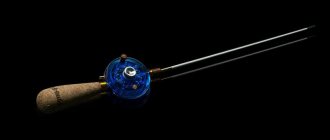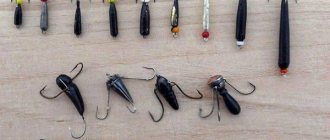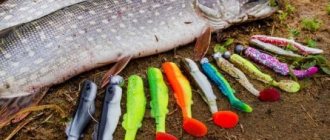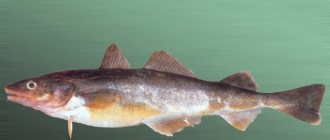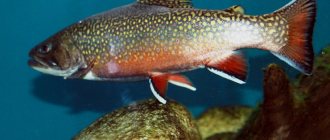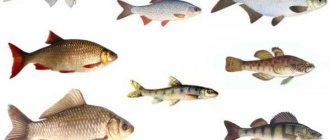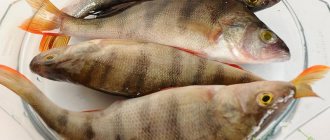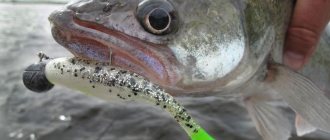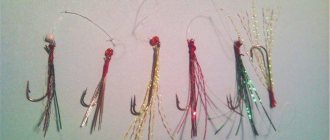With the development of new technologies, more and more new methods of fishing are being introduced into the art of fishing. One of these innovations was fishing with a retractable leash, which immediately established itself well among a wide range of fishing enthusiasts. Here you will learn how to properly install a diverter leash for pike perch, perch, pike, bream, roach, and you can also watch a video.
What kind of gear is this?
A retractable leash is, first of all, a universal tackle for catching predatory fish such as perch, pike perch and pike; however, retractable leashes are also good for catching catfish, roach, bream, burbot and some types of white fish that live in the bottom layers of water.
This universal tackle consists of a triple or double swivel, depending on the type of fishing, donk, spinning or float tackle, a weight, a piece of fishing line of various lengths and a hook with bait.
On spinning tackle, it is best to use a retractable leash with a jig head or spoon at the end, where it will be attached to the main line using a double swivel. This is done for two reasons, namely:
- If you have one leash, the likelihood of the bait getting tangled is zero, because the presence of a swivel prevents the leash from getting tangled or twisted.
- If you have a leash, which includes copper wire or braided fishing line, a predatory fish will not be able to bite the main fishing line and break away.
On float or bottom rigs, diverting leashes with double swivels are used, at the ends of which a sinker is attached on one side, and on the other, a well-pointed hook with bait. The third part of the swivel is attached to the central fishing line.
On bottom rigs, the presence of a diverting leash plays a very important role. Firstly , if there is a current on the water, you can hang an additional weight at the end of the leash, where the sinker is located, or replace the sinker with a heavier piece, which in turn improves the casting range of the tackle and prevents the bait from dragging along the bottom downstream.
Secondly , a cautious fish, such as bream or roach, will not see foreign objects, such as a sinker, next to the bait and, due to the current, which will play with the bait located at the end of the outlet leash, will grab the bait and get hooked.
As for the float tackle , the diverting leash plays a distracting role from the main tackle and, just as in the case of bottom tackle, if there is a current in the water, the bait will develop in the water, imitating a live snack for an unsuspecting fish.
Winter float rig with jig
In order to press the nozzle in the current to the bottom of the reservoir or for active fishing, a jig is often built into the equipment of a winter float fishing rod. Look at the picture drawn about this.
Moreover, with the correct selection of the weight of the jig in the water for the carrying capacity of the winter float, in the equipment of a winter float fishing rod, you can do without a sinker.
To do this, the weight of the jig tied to the end of the main line of the winter float fishing rod and the attachments on the outlet leads should slightly exceed the carrying capacity of the winter float. Then all the equipment is slowly immersed in the water.
But you already realized that this is not the best way to balance the equipment of a winter float fishing rod for promising fishing.
It will be much better (more convenient) to add the jig you like to the float, and compensate for the missing part of the load with a small sinker, of which you can roll out dozens of different weights in half an hour.
Then in my picture I will also add this sinker to the winter float rig and, for complete happiness, I will lift the jig from the bottom of the reservoir right under the nose of the voracious but lazy bream.
Float rig with jig and nod
What should change in the equipment of a winter float fishing rod when lifting a jig from the bottom and how can we carry out this operation? Obviously, there is only one way - by winding the fishing line onto the reel spool.
But then the slack in the fishing line disappears between the whip of the winter float rod and the winter float, which will lead to the fish feeling the powerful resistance of the under-ice equipment when biting on the pull of the bait.
With this method of fishing, I added a nod with a sensitive spring to the equipment of a winter float rod with a jig (see picture), which will not hurt at all when checking for the presence of fish at higher horizons.
The role of the nod in winter fishing conditions and the correct setting of a fishing rod with a float for promising fishing will be discussed below in the text and on the next page of the topic.
By the way, the nod on the winter fishing rod did not stop me when checking the balancing of the equipment before showing a video with a similar fishing story on my YouTube channel. Watch the video: Winter float rod with jig.
For the next topic, I’m drawing another picture with the equipment of a winter float fishing rod, consisting of a float, a main line with a leash and two sinkers, the bottom of which is the sub-sinker.
And we will analyze the conditions for promising fishing, when a high-quality nod is needed on the whip of a winter fishing rod with float equipment.
Installation of a branch leash
There are several types of installation of diverter leashes that are suitable for fishing for various fish, both with feeder or bottom equipment, and with spinning equipment. Also, depending on the time of year, different types of installation are used for flowing or standing water. Installation options are as follows:
- Blind installation (winter).
- Sliding installation.
- Spinning type of installation.
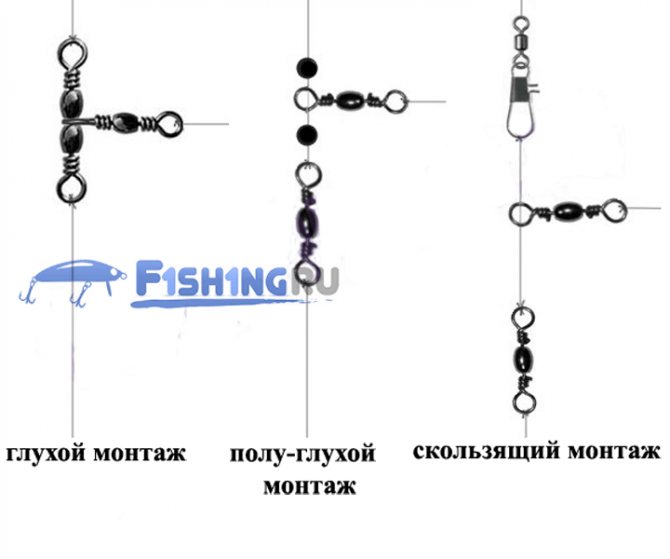
Solid installation
The blind rig is used in the winter season in still water and is intended for catching both perch, asp, pike and pike-perch, provided that the fishing will take place with the setting of a pole, as well as bream, white bream and other types of fish with a regular winter fishing rod.
For the blind installation of a branch leash you will need: a swivel, double or triple, which will be attached to the main fishing line using knots, a piece of fishing line 20-30 centimeters long, a hook, a sinker.
- A triple swivel is attached to the end of the main line using a loop knot and pulled tight.
- A prepared piece of fishing line with a hook at the end is attached to the other end of the swivel. Depending on the type and size of the fish, the hook is also selected according to the appropriate number.
- A weight is attached to the third end of the swivel, on a line of shorter length than the line of the diverter leash, to prevent the pieces of line from tangling.
- You can also use a blind mount on a correction rod, but with an appropriate weight.
Sliding installation
Sliding installation differs from blind installation in that the load slides along the main fishing line and the leash can freely go downstream until the main fishing line is tensioned.
This type of installation is more common from spring to autumn, on rivers with a current, but it can also be used in standing water even in winter. With this method of mounting the gear, bites will be the most sensitive, and all vibrations from the bait will be transmitted to the main line. For a sliding type of installation for a retractable leash, you will need two double swivels, two pieces of fishing line, one 15 centimeters and the other 20-25 centimeters, a weight, a hook and a stopper so that the swivels do not get tangled.
- A double swivel is threaded onto the main line, where a stopper is tied at its end so that the swivel rests against the stopper when sliding freely.
- 15 is attached to one end of the swivel . In this position, the load remains at the bottom, and the main line can freely develop with the flow.
- A second double swivel with a piece of fishing line 20-25 centimeters long and a hook at the end is attached to the other end of the stopper.
As for spinning rods , such installations are not suitable, because when retrieving, the sinker will catch on underwater rocks or vegetation and create the illusion of a bite. In this case, a spinning leash installation is used.
The spinning rig for a diverting leash is the simplest and most effective for catching predators. For it you will need a double swivel, a piece of strong fishing line, preferably braided, and the bait itself, which will be used to catch predatory fish.
- A swivel is attached to the end of the central fishing line using a good knot.
- A piece of fishing line with a loop for putting on the bait and the bait itself are attached to the swivel.
Due to the heaviness of the bait, a weight is not placed in this setup, since the bait is used at different depths.
Float rod equipment for catching roach, bream and crucian carp
Equipping a winter fishing rod with a rig with a float allows you to easily switch from summer fishing to winter fishing, and does not require special, additional skills. With such tackle you can catch bream, white bream, silver bream, roach, crucian carp and perch.
Selection of equipment elements
For a winter float fishing rod, the following equipment is used:
- You can choose any fishing rod for a winter fishing rod, since this tackle is quite stationary, its weight does not matter much. It is advisable that the handle be made of cork, wood or other heat-insulating material, so that it does not get cold on your hands when fishing. It is also desirable to have legs or another stand. The rod whip should be flexible enough so that it does not cause the fish to break when hooking.
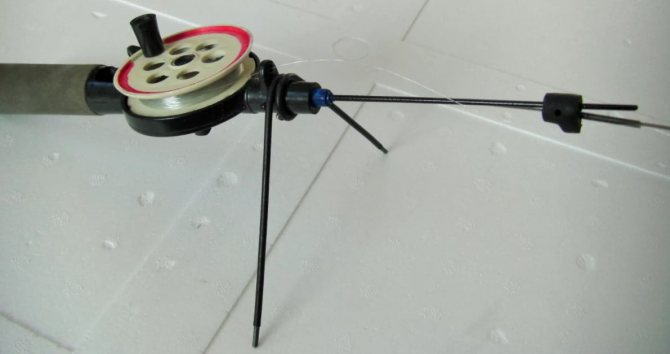
- The reel on a winter fishing rod can be of any type; its only purpose is to store fishing line.
- The fishing line is monofilament, preferably colored, which, unlike transparent, is easier to distinguish on ice or snow. As practice shows, for fish the color of the fishing line does not matter. As for the diameter of the main line, they recommend 0.15 - 0.18 mm, but here a lot depends on your preferences. Many fishermen complain that thin fishing line gets very tangled, and with a confident bite, the diameter does not matter much, and they prefer to fish with a fishing line of 0.2 - 0.25 mm.
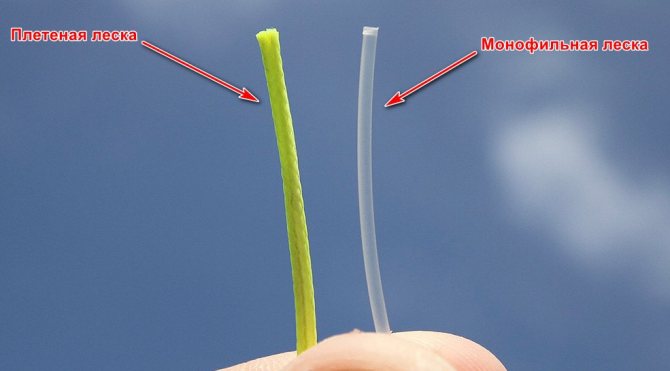
- The leash can be made from either a thinner line or the same diameter as the main line.
- The floats used for winter fishing are quite varied. They are usually small in size and come in double, single and multi-piece types. They can be attached either using a cambric or clamps, or by passing a fishing line through a through hole, clamped with an antenna pin. Some of the most catchy winter floats are, for example, floats of light colors, conical shape, with a wide upper end. However, it all depends on the habits and preferences of the fisherman.
- The weights are selected in such a way that, when loaded, the float is several centimeters below the water level and does not freeze against the ice. The weight of the load itself depends on the float, the method of loading and the current at the fishing site.
- The size of the hook will primarily depend on the fish you are going to catch. It doesn't have to be small. The main thing is that it is thin.
I catch roach, bream, crucian carp, etc. A winter float fishing rod uses live bait - bloodworms, maggots, jigs, etc.
Installation of equipment
Installation of a winter float fishing rod is quite simple. For it, in addition to the previously listed equipment elements, we will need scissors and pliers.
- We measure the fishing line, its length should be equal to two depths of the reservoir at the fishing site, plus 2 - 3 meters. This value is needed so that you have a reserve of fishing line in case of a break.
- We wind the fishing line onto the reel.
- We pass the fishing line through the rings on the rod or attach a cambric, ring or other element to it for attachment to the tip of the fishing rod.
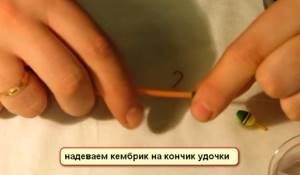
- Then we pass the fishing line through the hole in the float or put on an element that secures the fishing line to the float.
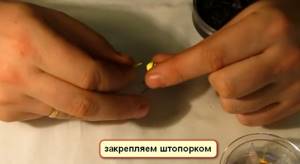
- The next step is loading the float. First, the main weight is attached to the fishing line, giving the float almost zero buoyancy. Below it we place a very small weight, which will submerge our float, and when lifted, the float will float up.
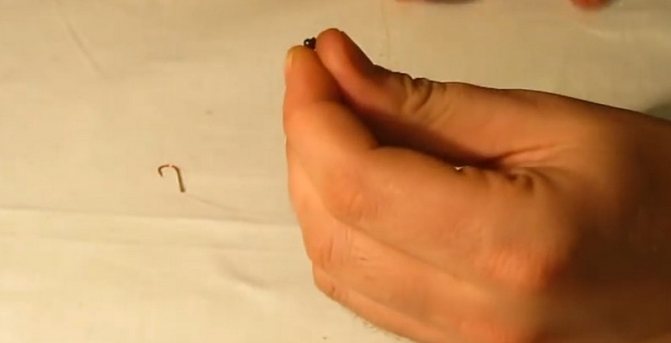
- Below the small weight, approximately 5 - 7 cm, we tie a hook, either on a leash, or directly to the main fishing line. In the second case, you need to make a knot on the fishing line just below the load, where the fishing line will break if it gets caught. Otherwise, we risk losing most of the gear, and not just the hook.
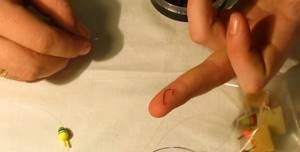
That's it, the winter fishing rod is ready for use
Leash for zander
Pike perch are caught exclusively using spinning gear and trolling. To catch it, bait is used in the form of lures made of silicone, spinners, and deep wobblers, since pike perch prefers to live in the bottom layers of the aquatic environment. The leash for spinning fishing for pike perch must be strong and made of braided fishing line or thin copper wire, which the pointed teeth of a predator cannot bite through.
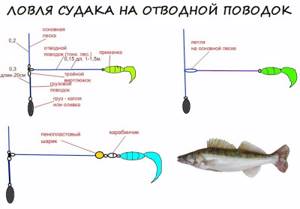
Also, a copper wire leash prevents the main line from catching on the pike perch’s dorsal fin, which is very sharp and can easily cut any line except braided line. Also, when making a leash for catching pike perch, it is worth taking into account the integrity of the swivel, which can break due to wear and a long stay in the water.
Leash for perch
Perch is much smaller in size than pike perch and leashes for catching it can be made from monofilament fishing line, which has a transparent color and is less noticeable in the water column. As bait for perch, small spoons and wobblers are attached to the end of the leash. In order to cast further when catching this type of predator, it is worth using the main line of a braided type, since it is lighter than monofilament. When fishing for perch with a jig head in snags or a grassy bottom of a reservoir, it is better to make leashes from braided fishing line so as not to break the bait, which is very expensive.
- Sinker weighing 10-30 grams.
- Leash length 50-120 cm.
- Length to load 15-30 cm.
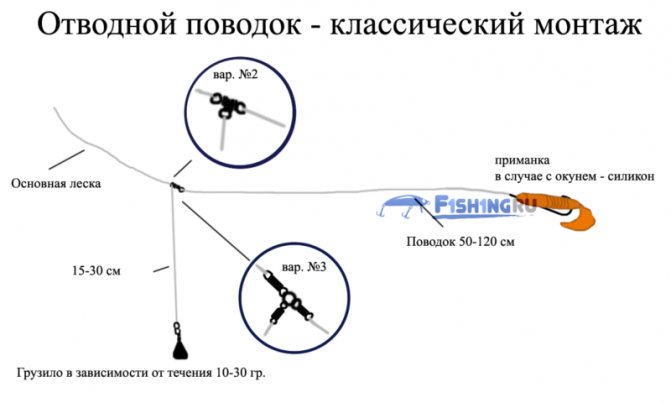
Winter float rod rig nod
The nod is correctly integrated into the equipment of a winter float fishing rod by fishermen pursuing two goals.
Firstly: a nod is necessary for prospective fishing in winter above the ground in a reservoir with muddy bottom water and a heavily silted bottom.
That is, when the bait in the winter float fishing rod is not at the bottom of the lake, pond, or river.
But even in clean reservoirs with an abundant food supply, fish do not always bite exclusively from the bottom. This is the second reason for the presence of a nod in the equipment of a winter float fishing rod.
And you can find the horizon of more promising fishing, for example, at the site of a school of roach, by slowly raising the nozzle on the hook of a winter float rod with simultaneous oscillations of the nod spring.
Further, the equipment of the entire set of available winter fishing rods can be configured for fishing on a more promising horizon. This is exactly the moment captured in my picture.
Neither the nod nor the float will notice the rise of the bait until the fish raises the bait above the sinker of the winter float rod. As the lower sinker rises, the float will float higher and higher in the hole.
It turns out that the nod spring for the entire equipment of a winter float fishing rod plays the role of an upper stop when fishing with tackle with a nozzle raised above the bottom.
For a similar method of correct equipment and the nod reaction to a fish bite, see the video on my YouTube channel in the video Winter float rod with a sinker under the hook.
Pike leash
To catch pike with this type of leash, leashes made of durable material, such as copper wire, are used, since the predator, like pike perch, has pointed teeth that can easily bite through a leash made from ordinary fishing line. In the winter season, when fishing for pike on girders, it is better to take a thick monofilament line as the central line and a copper wire leash, since the bait in this case is active live bait, which, with the lightness of the main line and the outlet leash, can make a false bite.
- Monofilament for leash 0.2;
- Main line 0.25;
- Sinker from 20 grams, depending on the current. On a strong one, it makes sense to use weights of 50 grams or more.
- The length of the leash to the wobbler is 40-150 cm.
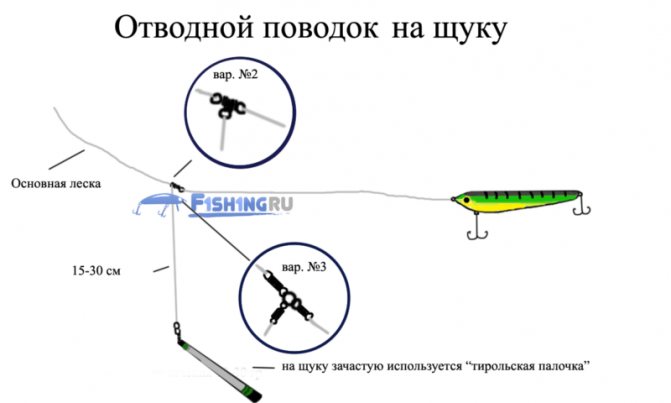
Nod of a winter float rod
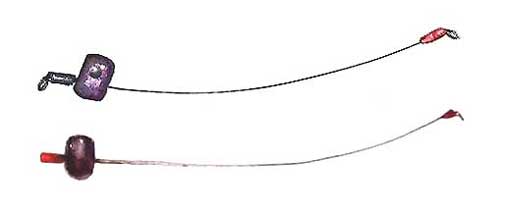
To make winter fishing more promising, both with a jig and a float rod, I build into the equipment the same nods with springs of a spring system, invented at least forty years ago.
To reduce the impact of side wind gusts on the shock absorbers during the adjustment process, I extend the sensitive springs into a straight line, taking into account the weight of the equipment of each winter float fishing rod in the water: nozzles on the hooks of the diverter leashes and sinkers on the main fishing line.
After all this equipment is immersed in the water, the nod spring is set to a horizontal position using bending, which corresponds to the maximum sensitivity of the shock absorber spring to fish bite.
The nod in the equipment of a winter float rod provides the fisherman with the opportunity to fish actively (at least periodically), raising the nozzle on the main line and on the outlet leash above the selected level for stationary fishing.
Then the nod becomes the main one, and the float becomes a secondary element of the equipment until it is immersed in the water. We are not going to constantly play with the nozzle, as usual.
Also, the flexible elastic spring of the nod provides additional shock absorption for the jerks of large fish caught on the hook, thereby preventing the breakage of the main fishing line and even the leash in the equipment of a winter float fishing rod.
Therefore, a nod of the appropriate action will not hurt us, especially if a thin main or leader line is built into the equipment of a winter float fishing rod. But it’s up to you to decide, given that few nods advertised on websites are generally suitable for winter and summer fishing.
Winter diverter leash
A winter leash is used both for fishing with garlands and with fast-action winter fishing rods, but most often a winter retractable leash is used when fishing with bottom tackle with a float.
Applies to:
- Bream;
- Roach;
- crucian carp;
- Perch.
Often, when bottom fishing in winter, a feeder is used, this is especially effective when catching roach and bream.
Tackle diagram:
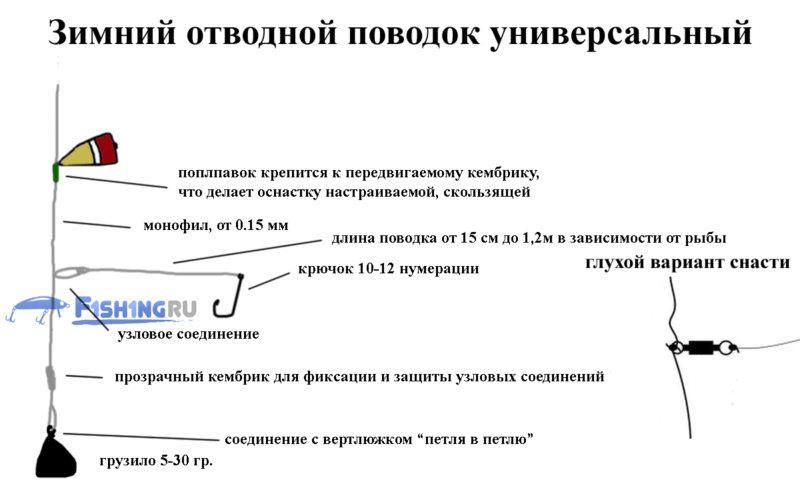
This retractable leash can be used in combination with a feeder. Such bottom tackle precisely feeds the fish, luring it, and the tackle itself is sensitive when biting.
The main line is taken with a thickness of 0.15. For large fish, a fishing line of 0.18 mm is used. The leash itself is made from monofilament fishing line, slightly narrower than the main one.
Sinkers for small species without current - from 5 grams. For medium without flow from 10 grams. For large ones over 30 grams.
Installation of a winter diversion leash according to Salapin, video:
Winter stationary fishing
Winter fishing with a fishing rod may also be preferable not only because of the angler’s personal preferences for the float. The choice of method is determined by the reservoir itself. Fishing with a winter fishing rod with a float is used mostly for bottom fish - bream, crucian carp. It’s still better to catch perch using an active jig. Roach, depending on conditions, responds well to both fishing methods. Stationary fishing with a winter fishing rod is a separate large area of fishing, with its own nuances and features of tactics, technique and equipment.
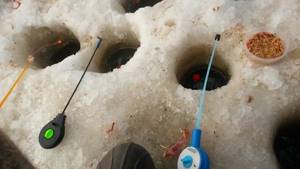
Ice fishing
Along with active jigs, stationary ice fishing with fishing rods is probably the most common method of winter fishing. The choice of fishing method depends on the characteristics of the reservoir and the local traditions of fishermen. A pattern is clearly visible - in some places the majority of ice fishermen prefer jigs for play, in others they prefer “sedentary” fishing with rods.
- If the emphasis in jigs is on active search and movement, then in stationary fishing with rods the emphasis is on initially strategically choosing the right place and time with a competent feeding system.
- In many ways, the success of stand-up fishing is determined by bait and bait. However, this does not mean that fishing rods on the spot for winter fishing is a passive activity. Active search is also used - it’s just that the overall speed of the fisherman’s movements is noticeably lower.
- Each feeding point is carefully fished with fishing rods - it takes time for the feeding to collect the fish, sometimes more than an hour. If it doesn’t bite, then the fisherman moves on. You shouldn’t sit on one hole all day if you don’t bite at all.
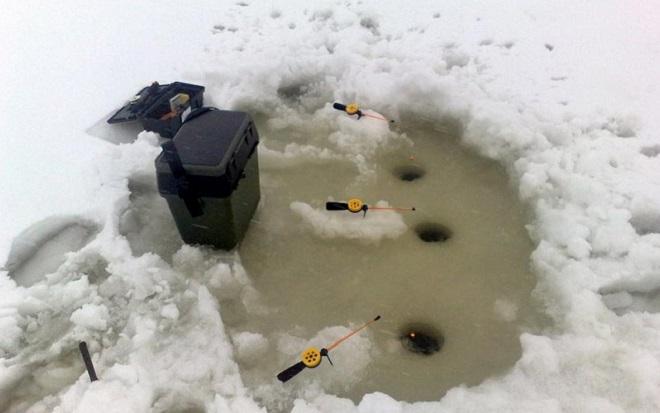
How to tie a leash to the main line
Our rating of knots, including for the leash. How to tie a leash to the main line? As easy as pie:
- The main unit for attaching the diverter leash is considered to be an improved clinch (Fig. below) , which reaches 97% . It is knitted by threading the main line into the ring of a swivel and winding several turns around it, followed by tightening the end of the line.
- Also very common, especially among novice fishermen, is the usual double knot , which is most recommended to do if the main fishing line is braid, since it is softer than monofilament fishing line and will not slip or come undone.
- The bayonet knot is a knot that has some similarities to the improved clinch, the only difference is that with each skein a knot is made around the main line.
- And the best and easiest to use when tying diverter leashes is the figure eight , which, with simple manipulations with the main fishing line around the swivel, forms a connection similar to the number eight. This knot is 95 percent effective and is suitable for all types of fishing line.
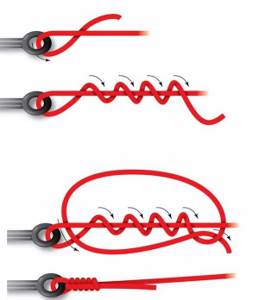
Common clinch
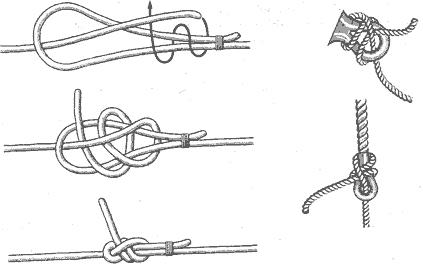
Clew Double knot Figure eight knot
How to install a winter donk with your own hands
The most famous and popular donkey equipment for winter fishing is called a “load” and its assembly takes from 5 to 10 minutes. Usually fishermen knit rigs at home, in comfortable conditions, but if a jig or hook breaks during fishing, restoring the functionality of the gear is not at all difficult.
In order to mount a winter donk “truck” you will need:
- winter fishing rod with reel;
- nod;
- sliding weight;
- float stops;
- 2 jigs;
- monofilament line with a diameter of 0.2 mm.
Instead of jigs, small hooks for bloodworms or maggots are used, it all depends on the fishing tactics chosen by the fisherman and the expected trophies. Some fishermen use a self-hooking hook on the bottom for winter fishing, which guarantees that after a bite the fish will be hooked. The use of self-hooking hooks is the choice of every angler and it all depends only on one’s own preferences.
The procedure for installing the “truck” bottom:
- Wind the line onto the reel.
- Attach a nod to the fishing rod.
- Thread the fishing line through the rings and pull it through the nod.
- At a distance of 20–30 cm from the end of the fishing line, make a branch for the upper jig 7–10 cm long;
- Place a stopper on the line and stretch it all the way to the outlet.
- Place a weight on the fishing line.
- Place another stopper so that the distance between them is 15 cm.
- Tie a jig to the end of the fishing line.
- Tie the second jig to the outlet.
The advantages of a “truck” winter fishing rod are that the jigs are located at a distance of 23–25 cm from each other and one moves along the bottom, and the second floats in the water column. This increases the likelihood of a bite, which means the catch will be larger.
It is better to fish with “trucks” in the current, then both jigs move in the water column parallel to each other. A sliding weight presses the tackle to the bottom, but at the first moment after the fish bites, it does not create obstacles and does not frighten it.
After pulling the jig, the fish is hooked under the weight of the load, even if self-hookers are not used. The “truck” is not only a simple, but also a catchy equipment, characterized by high sensitivity, which is important when catching inactive fish.
Jigs are preferable to hooks in that they are used both with and without baits, and it is easier to determine the preferences of the fish at a given time and in a given place.
There are jigs:
- light-accumulating;
- reflective.
Light-accumulating jigs are best used when fishing at night because their glow attracts fish. Reflective baits are more catchy in daylight. When choosing the colors of jigs, the angler is guided by his preferences and information about which baits work best in a given body of water.
Instead of monofilament, fishermen use fluorocarbon fishing lines as a base, which, although more expensive, have advantages. Fluorocarbon is hardly noticeable in water, it is a hard and frost-resistant material, so it is considered the most suitable for winter fishing.
Important! When installing the “Truck”, it is better to use a sliding sinker in the shape of an olive, streamlined shape.
Winter donka without a fishing rod
A fishing rod with a nod for winter fishing is necessary in order to see the lightest fish bites. When fishing for bream or perch, use a winter donka without a crow tail fishing rod. The advantage of this donkey is that when fishing with 5-7 rigs, the angler does not have to constantly monitor the position of the tackle; the fish are caught under the weight of the load.
Having prepared the required number of holes, the fisherman lowers the equipment on a reel into the water and when bitten, it turns over vertically, somewhat reminiscent of a crow’s tail. The reel should be dark in color to contrast with the snow and ice and its position should be visible from a great distance.
When installing the reel in a hole, a wooden strip 10–15 cm long longer than the width of the hole is threaded under the main fishing line wound around it. It turns out that the wooden plank is placed across the hole and the hooked fish will not drag the tackle into the water. The reel is located parallel to the ice, and after a bite, under the pressure of the fish, it turns over 90 degrees.
The work of the “crow’s tail” is somewhat reminiscent of the work of a girder, only there, after a bite, the flag becomes vertical, and in this case the reel. The tackle is very simple and catchy, not only for bream, but also for roach, bluegill and other white fish.
When making it, first of all you need to prepare the reels and they are cut out of dense dark plastic or bought at a fishing store. For ease of assembly and fastening of hooks, a piece of foam rubber or rubber insulation for windows and doors is glued to the reel.
The sizes of the hooks depend on the size of the baits used, and the length of the leader varies depending on the strength of the current. The stronger the current, the longer the leash is placed on the bottom, and after casting the tackle it will spread parallel to the bottom. The main line is monofilament or fluorocarbon, it all depends on the preferences of the fisherman and his financial capabilities.
A sliding sinker for donkey can be easily smelted at home using lead insulation or plates from batteries. The weight of the load also depends on the strength of the current, and ranges from 30 to 100–120 grams.
To install the donkey you will need:
- prepared reel with fastenings for hooks;
- sliding weight 30–120 grams;
- float stop;
- triple swivel;
- two leashes with hooks on a fishing line with a diameter of 0.14-0.18 mm;
- The main line is 10–15 meters long, 0.2 mm in diameter.
A triple swivel can be replaced with a wire rocker, but this makes the tackle rougher, which is best avoided.
We mount the donk:
- Wind the main line onto the reel, tying the end tightly.
- Place a sliding weight on the free end.
- Install the float stopper.
- Attach a triple swivel and lower the stopper to it.
- Attach leashes with hooks to the swivel ears.
The weight moves freely along the fishing line, and the float stopper protects the knot with which the swivel is tied from impacts when biting and lowering the tackle into the hole. The length of the main line depends on the depth at the fishing spot, because there must also be a reserve for comfortable landing of fish.
Biting a heavy trophy will require additional meters of fishing line, so the angler must be fully prepared, as well as his tackle.
The design of the winter donkey on a reel is reminiscent of the summer version of the bottom tackle, but the length of the leashes in it is longer, because the tackle is lowered into the hole, and not thrown by hand at 30–40 meters, which is inconvenient to do with long leashes.
Important! When fishing in winter, you need to have a supply of weights of different weights, especially when fishing in currents, which can become stronger.
Fishing technique with a retractable leash
When fishing with a retractable leash, there are several important rules. Namely:
- When fishing with bottom tackle, it is important that the line is in a taut position, so that when a fish bites, the reaction of the bite at the tip of the rod is instantaneous.
- When casting, you need to make sure that the retractable leash and the leash with the sinker are not mixed up, otherwise the bait will not be effective in the current in the water, or even in flight it may be knocked off the hook by the sinker.
- When using the bottom fishing method, in some cases a method called dotted feeding is used, when after casting and after a certain period of time, usually 2-3 minutes, the bait is pulled 20-30 centimeters from its original location. This method is used to prevent the bait from caking on the bottom and raising a small cloud of turbidity that attracts fish.
- When fishing with a spinning rod, they use their own methods of fishing with a retractable leash, which include slow and fast retrieves along the bottom, retrieves with sharp jerks and waiting pauses between them, aggressive retrieves, which include several approaches with jerks and pauses.
An extremely important role in fishing with a diverting leash is assigned to sinkers , which must be selected depending on the strength of the current , depth and bottom topography . For example, when fishing for bream at great depths and with a sandy bottom, long and bullet type sinkers are used. And in snagy terrain and in some spinning rigs with a lead lead, sinkers such as a Tyrolean stick and a drop shop are used.
In winter (late autumn), when fishing on the current, it is best to use a blind leash rig so that the main line does not touch the ice cover and does not rub against it, however, in winter the fish are more careful and it is more difficult to notice a bite, and professional fishermen prefer a sliding rig so that they can catch fish in time. notice the slightest touch of the fish to the bait.
Also, when fishing for fish, you need to take into account that after biting you do not need to make a sharp jerk with the rod, because the mass of the fish and sinker can break the main line or break the rod. It is best to make a small hook so that the fish sits securely on the hook and, using gradual wave pulls and winding the fishing line onto the clutch of the reel, pull the fish to the shore or into the landing net.
Side leash on winter gear
- VK
In winter, especially when the bite is weak, a jig alone often does not save the day. The fish may not like an excessively large object, the mass of the bait, or unnatural, sudden movements. During the first ice, when the fish greedily pounces on everything that moves, there are no such problems, but with the advent of deep winter and the deterioration of the bite, you have to fight for each bite, using various kinds of tricks. For example, place a leash with a small hook above the jig.
In still water
Using a lead rig, you can catch perch and roach equally well in still water, in a shallow pond, and bream in a deep, stagnant hole in a lake or reservoir. Lead rigging is often used when catching live bait for girders in the dead of winter, which can be difficult to catch at this time. And when every bite counts, a leash is very helpful. It is also good for catching active perch standing at different horizons in the water column, especially in stagnant ponds, when the predator begins to lead a pelagic lifestyle, completely detached from the bottom. A leash and a jig, located at some distance from each other, help you quickly find the level where the perch stands.
Equipment
You need to know how to tie a leash correctly. The hook should not cling to the main line, as this may cause the fish to feel the catch, especially in conditions of weak bite. With a properly knitted leash, the bite is better transmitted to the nod, which immediately records any movement of the bait when biting both down and up, which does not happen so rarely.
For the leash, choose a thicker and stiffer line than the main one: if the main line has a diameter of 0.08 mm, then the leash is 0.1-0.12 mm. This increases the consumption of jigs during snags and breaks, but the quality of the equipment requires sacrifices. A short and stiff leader is more sensitive to the touch of the fish. By experimentation, the optimal length of the leash for standing water is selected, which is 1.5-2 cm. Less is possible, but not more.
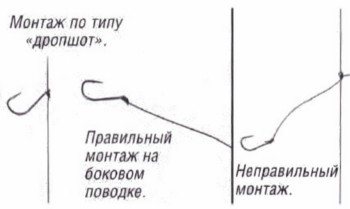
With a length of 3 cm or more, the sharpness of the bites is “smoothed out” and they become less noticeable. In addition, the game that we strive to give to the hook is not conveyed. In addition, after catching five to seven medium-sized fish, the leash loses its rigidity and hangs in contact with the main line; in still water, a significant percentage of bites are lost. So it’s better not to be lazy and tie a new leash or take a spare fishing rod.
Live bait fishing
In the deep winter, the daylight hours are short, and the obvious peak of bites occurs only in the morning, so you have to catch live bait at an accelerated pace, and every bite counts. To catch live bait, a lead rig is almost always used. They find the bottom and check the bottom layer with a nod tackle. Make three to five active retrieves, then leave the equipment on the bottom without moving for 2-3 minutes. If the fish does not react, they knock on the bottom and again leave the tackle motionless for a while. If during this time there is no bite, you can safely change the place.
If the fish pecked or poked the bait, but there was no further action, then the following technique is used. Place the jig on the bottom and give the line a little slack, literally 2-3 cm, then in the slack area they begin to actively shake the fishing rod. It turns out that the jig is not involved in the game, but only the leash moves, very easily (because there is no influence of the mass of the jig) and practically in one place. Perch responds very well to this technique.
Perch fishing
Perch can be found easier and faster with a spinner. At the beginning of fishing, they put a lure, above it they tie a leash with a hook on which they wind the hair, and I look for a school. Having found fish in this way, they continue to fish with a spoon and fly. However, this is more often the case. that the perch pokes the spoon or fly only a couple of times, reveals itself, and then stops responding to such baits. In this case, note the level at which the fish pecked, and take out the tackle with a jig and a leash.
You should not start wiring from the level at which the perch has just been biting. It is better to lower the jig to the bottom and raise it to the horizon where the bites occurred, and a little higher. A passive perch stands in the bottom layer and sluggishly rises up behind the jig, but at some level from the bottom its instinct to pursue elusive prey is triggered, and it boldly attacks the bait.
Catching "white" fish
When searching for “white” fish in stagnant backwaters of reservoirs, they begin to play with the tackle at half-water, slowly lowering the bait. White bream and roach often attack it not at the very bottom, but a little higher. In this case, a lead rig is a universal fishing method that allows you to simultaneously fish from the bottom with a stationary bait and play in the bottom layer. It looks like this. Slowly lowering the jig to the bottom, within one to two minutes, with smooth movements, raise the equipment no higher than 1 m from the bottom and lower it very slowly, with stops. If the “white” fish is more or less active, it attacks the descending bait. If no bites occur during this time, send the jig to the bottom, but do not put the fishing rod on the ice. Often the nod takes off 1-2 seconds after the jig reaches the bottom. Moreover, the nod often rises in both cases: when the fish takes the jig, and when it attacks the leash. This is evidence that the fish is not standing at the bottom, but slightly higher. But usually “white” fish respond better to the leader in the lowering phase. The game then needs to be smooth, sweeping, with periodic pauses.
A bite, as a rule, occurs at the moment when the bait slowly falls down, and is transmitted to the nod as a slight failure or stop during retrieval. And sometimes the nod can jerk down sharply. When fishing like this, it is important to set the length of the leash correctly: too short will not provide the necessary smoothness of the game, and if it is too long, many bites may simply not be noticed. The optimal leash length when fishing while the gear is being immersed is 2-2.5 cm.
Related articles:
Mormyshka "devils"
Mothless "Goat". Making tackle
Reelless: assembly and fishing tactics
Night fishing for bream in winter
